
Italian postcard by NMM, Milano, 1941. Caption: Joan Blondel (sic), actress endowed with all the refinements, with a serene face, but full of sweet femininity.

British postcard. Photo: First National Films.
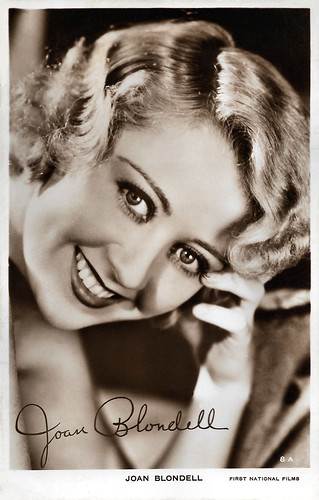
British Real Photograph postcard, no. 8 A. Photo: First National Films.

British postcard by Valentine's in the Film Stars and their Pets series, no. 5843 G.
The Bouncing Blondells
Rose Joan Blondell was born to a Vaudeville family in 1906 in Manhattan, New York City. Her father, Levi Bluestein was a vaudeville comedian, known as Ed Blondell. Her mother was Kathryn ('Katie') Cain, and her younger sister, Gloria Blondell, also an actress, was briefly married to film producer Albert R. Broccoli. Blondell also had a brother, Ed Blondell, Jr.
Her parents moved from place to place and Joan made her first appearance on stage at the age of four months when she was carried on in a cradle as the daughter of Peggy Astaire in 'The Greatest Love'. Her family comprised a vaudeville troupe, the 'Bouncing Blondells'. Joan had spent a year in Honolulu (1914–1915) and six years in Australia and had seen much of the world by the time her family settled in Dallas, Texas when she was a teenager. Under the name Rosebud Blondell, she won the 1926 Miss Dallas pageant, was a finalist in an early version of the Miss Universe pageant in May 1926, and placed fourth for Miss America 1926. She attended Santa Monica High School. She attended what is now the University of North Texas, then a teacher's college, in Denton, where her mother was a local stage actress.
Around 1927, she returned to New York and worked as a fashion model and a circus hand. She joined a stock company to become an actress. She made her New York debut with the Ziegfeld Follies and appeared in several Broadway productions. In 1930, she starred with James Cagney in 'Penny Arcade' on Broadway. The show lasted only three weeks, but Al Jolson saw it and bought the rights and sold them to Warner Bros. with the proviso that Blondell and Cagney be cast in the film version.
Placed under contract by Warner Bros., she moved to Hollywood. Blondell was paired with James Cagney in Sinners' Holiday (John G. Adolfi, 1930), the film version of 'Penny Arcade', and it was a success. In The Office Wife (Lloyd Bacon, Michael Curtiz, 1930), she stole the scene when she was dressing for work. She would be teamed with Cagney again in The Public Enemy (William A. Wellman, 1931) and Blonde Crazy (Roy Del Ruth, 1931). That year, Blondell was named one of the WAMPAS Baby Stars of 1931. During the Great Depression, Blondell was one of the highest-paid individuals in the United States. She co-starred with Dick Powell and Ruby Keeler in the Busby Berkeley hit musical Golddiggers of 1933 (Mervyn LeRoy, 1933). Her stirring rendition of 'Remember My Forgotten Man' became an anthem for the frustrations of the unemployed and the government's failed economic policies.
Establishing herself as a sexy wisecracking blonde, Joan Blondell had become a staple of Warner Brothers. She would be paired with Dick Powell in ten musicals during these years, six films with James Cagney and was one-half of a gold-digging duo with Glenda Farrell in nine films. In 1937, she starred opposite Errol Flynn in The Perfect Specimen (Michael Curtiz, 1937). By the end of the decade, she had made nearly 50 films. She left Warner Bros. in 1939.

Dutch postcard by City Theater. Sent by mail in 1934. Photo: Warner Bros. Publicity still for Golddiggers of 1933 (Mervyn LeRoy, 1933).
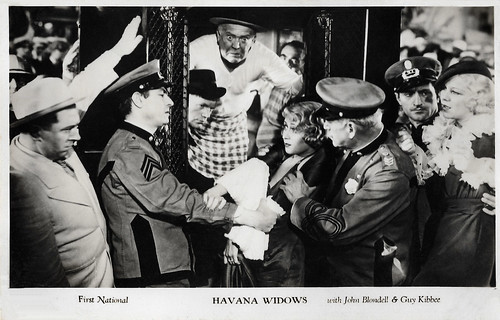
British postcard in the Filmshots series by Film Weekly. Photo: First National. Joan Blondell, Guy Kibbee and Glenda Farrell in Havana Widows (Ray Enright, 1933).

British postcard in the Filmshots series by Film Weekly. Photo: Warner. Joan Blondell and Pat O'Brien in I've got Your Number (Ray Enright, 1934).

British Art Photo postcard, no. 159. Photo: Joan Blondell and Dick Powell in Gold Diggers of 1937 (Busby Berkeley, 1936).
Something for the boys
In 1943, Joan Blondell returned to Broadway as the star of Mike Todd's short-lived production of 'The Naked Genius', a comedy written by Gypsy Rose Lee. She was well-received in her later films, despite being relegated to character and supporting roles after 1945 when she was billed below the title for the first time in 14 years in Adventure (Victor Fleming, 1945), which starred Clark Gable and Greer Garson. She was also featured prominently in A Tree Grows in Brooklyn (Elia Kazan, 1945) and Nightmare Alley (Edmund Goulding, 1947) starring Tyrone Power.
In 1948, she left the screen for three years and concentrated on theatre, performing in summer stock and touring with Cole Porter's musical, 'Something for the Boys'. She later reprised her role of Aunt Sissy in the musical version of 'A Tree Grows in Brooklyn' for the national tour, starred opposite Tallulah Bankhead in the play 'Crazy October' (which closed on the road) and played the nagging mother, Mae Peterson, in the national tour of 'Bye Bye Birdie'.
Blondell returned to Hollywood in 1950. Her performance in her next film, The Blue Veil (Curtis Bernhardt, Busby Berkeley, 1951) starring Jane Wyman and Charles Laughton, earned her an Academy Award nomination for Best Actress in a Supporting Role. She played supporting roles in The Opposite Sex (1956), Desk Set (1957), and Will Success Spoil Rock Hunter? (Frank Tashlin, 1957) as a mature companion to Jayne Mansfield.
Was nominated for Broadway's 1958 Tony Award as best supporting or featured actress (dramatic) for 'The Rope Dancers'. She received again considerable acclaim for her performance as Lady Fingers in Norman Jewison's The Cincinnati Kid (1965), garnering a Golden Globe nomination and a National Board of Review win for Best Supporting Actress.
John Cassavetes cast her as a cynical, ageing playwright in his film Opening Night (1977). Blondell was widely seen in two films released not long before her death, Grease (Randal Kleiser, 1978) starring John Travolta, and the remake of The Champ (Franco Zeffirelli, 1979) with Jon Voight and Rick Schroder. She also appeared in two films released after her death, The Glove (Ross Hagen, 1979) and The Woman Inside (1981).
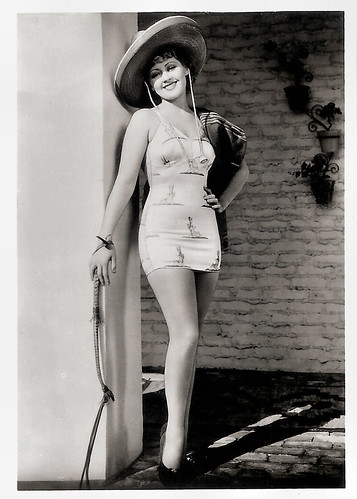
British cigarette card by State Express and Ardath Cigarettes, Series two, number 9. Photo: First National.

British Real Photograph postcard. Photo: First National & Vitaphone Pictures.
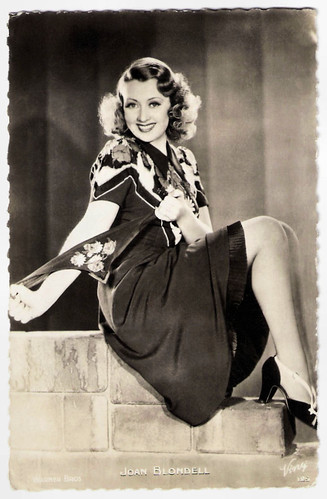
French postcard by Viny, no. 125. Photo: Warner Bros.

British Best Wishes card. Photo: R.K.O. Radio.
If you don't like it, you can get the hell out
Joan Blondell guest-starred in various television programs, including three 1963 episodes as the character Aunt Win in the CBS sitcom The Real McCoys, starring Walter Brennan and Richard Crenna. In 1964, she appeared in the episode What's in the Box? of The Twilight Zone. She guest-starred with Joe E. Brown and Buster Keaton in the episode You're All Right, Ivy on Jack Palance's circus drama TV series, The Greatest Show on Earth (1963–1964). In 1965, she was in the running to replace Vivian Vance as Lucille Ball's sidekick on the hit comedy series The Lucy Show. Unfortunately, after filming her second guest appearance as Joan Brenner (Lucy's new friend from California), Blondell walked off the set right after the episode had completed filming when Ball humiliated her by harshly criticising her performance in front of the studio audience and technicians.
Blondell continued working on television. In 1968, she guest-starred on the sitcom Family Affair, starring Brian Keith. She replaced Bea Benaderet, who was ill, for one episode on the CBS series Petticoat Junction. That same year, Blondell co-starred in all 52 episodes of the Western series Here Come the Brides, co-starring singer Bobby Sherman and actor-singer David Soul. Blondell received two consecutive Emmy nominations for outstanding continued performance by an actress in a dramatic series for her role as Lottie Hatfield. In 1971, she followed Sada Thompson in the off-Broadway hit 'The Effect of Gamma Rays on Man-in-the-Moon Marigolds', with a young Swoosie Kurtz playing one of her daughters. In 1972, she had an ongoing supporting role in the TV series Banyon, starring Robert Forster. Blondell played the wife of Tom D'Andrea's character in the television film, Bobby Parker and Company (1974), featuring Ted Bessell as the son of Blondell and D'Andrea.
Blondell was married three times, first to cinematographer George Barnes in 1933. They had one child — Norman Scott Barnes, who became a producer, director, and television executive — and divorced in 1936. In 1936, she married actor, director, and singer Dick Powell. They had a daughter, Ellen Powell, who became a studio hair stylist, and Powell adopted her son from her previous marriage under the name Norman Scott Powell. Blondell and Powell were divorced in 1944, and Blondell was less than friendly with Powell's next wife, June Allyson. According to Time magazine (24 July 1944), Blondell divorced Dick Powell on the grounds of cruelty alleging that "when she objected to the incessant coming and going of guests, Powell crooned: 'If you don't like it, you can get the hell out.'"
In 1947, Blondell married her third husband, producer Mike Todd, whom she divorced in 1950. Her marriage to Todd was an emotional and financial disaster. She once accused him of holding her outside a hotel window by her ankles. He was also a heavy spender who lost hundreds of thousands of dollars gambling and went through a controversial bankruptcy during their marriage. While continuing to live the high life on a huge estate in New York's Westchester County, Todd ran through Blondell's savings.
Joan Blondell wrote a novel, 'Center Door Fancy' (1972), which was a thinly disguised autobiography with veiled references to June Allyson and Dick Powell. Blondell died of leukaemia in Santa Monica, California, on Christmas Day, 1979, with her children and her sister at her bedside. She is interred in the Forest Lawn Memorial Park Cemetery in Glendale, California.
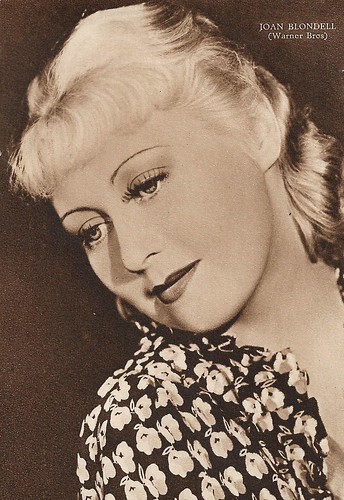
Italian postcard by Rizzoli & C., Milano, 1936. Photo: Warner Bros.

American postcard by K Ltd. Joan Blondell and Errol Flynn in The Perfect Specimen (Michael Curtiz, 1937).

British Real Photograph postcard in the Film Partners Series, London, no. P 245. Photo: Columbia. Melvyn Douglas and Joan Blondell in There's Always a Woman (Alexander Hall, 1938).

French postcard by Europe, no. 334. Photo: Warner Bros. Collection: Marlene Pilaete.
Source: Tony Fontana (IMDb), Wikipedia and IMDb.
This post was last updated on 6 June 2023.
No comments:
Post a Comment